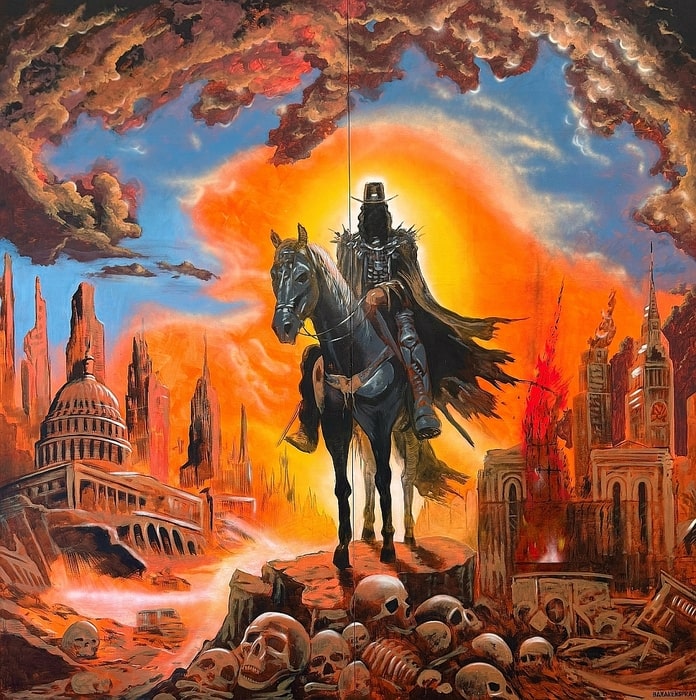In the Constantine Basilica, the Evangelical Church of the Saviour in Trier, the Cologne artist Thomas Baumgärtel, who has made a name for himself in art history as a banana sprayer, is showing the four apocalyptic horsemen under the title ‘Apocalypse’. The exhibition will be on display until 24 November 2024.
Image above: Roter Reiter, Thomas Baumgärtel, ©️ VG Bild-Kunst, Bonn.
‘And I looked, and behold, a pale horse. And he who sat on it had the name of Death, and hell went with him.” (Rev 6:8)
In the Constantine Basilica, the Evangelical Church of the Saviour in Trier, the Cologne artist Thomas Baumgärtel, who has made a name for himself worldwide in art history as a banana sprayer, is showing the four apocalyptic horsemen under the title ‘Apocalypse’. In four large-format works (4 x 4 metres), each showing a horseman, Baumgärtel takes up the well-known biblical metaphor described in the Book of Revelation and reinterprets it – as a symbol for the pressing global challenges of our time. Traditionally, the horsemen stand for four events that herald the end of the world and are therefore regarded as harbingers of the end of the world.
Baumgärtel’s work is different: as the artist says, his white rider symbolises the spread of ideologies and spheres of influence by political, economic and digital powers. He stands for the dangers of artificial intelligence, increasing digitalisation and the suppression of civil liberties.
In Baumgärtel’s work, the red rider represents ongoing armed conflicts, terrorism and global militarisation, which underline the urgent need for peace efforts.
The Black Rider addresses the challenges of food security, exacerbated by climate change and the unequal distribution of resources.
The pale horseman symbolises deaths caused by pandemics, diseases and environmental disasters as well as the loss of biodiversity.
Thomas Baumgärtel explains his depictions as follows: ‘I want to emphasise a strong contrast between beauty and destruction, thereby emphasising the duality of human experience. This includes the capacity for hope and renewal even in the midst of the deepest crises.’ He adds: ‘By linking global problems with individual experiences, the exhibition enables visitors to relate the universal themes to a personal level.’
Baumgärtel’s four horsemen reflect the diversity and complexity of the problems facing humanity today.
Thomas Baumgärtel emphasises: ‘There is a hope that we will all come together with just one goal. But it feels like we’ve fallen back into the Cold War. There is still a long way to go.’
The ‘Apocalypse’ exhibition with the four large-format (4 x 4 metres) horsemen can be viewed until 24 November 2024 in the Evangelical Church of the Redeemer, Constantine Basilica, Konstantinplatz 10, in Trier during regular opening hours at.
The ‘Apocalypse’ exhibition with the four large-format (4 x 4 metres) horsemen can be viewed until 24 November 2024 in the Evangelical Church of the Redeemer, Constantine Basilica, Konstantinplatz 10, in Trier during regular opening hours at.
Thomas Baumgärtel
Thomas Baumgärtel, known as the ‘Banana Sprayer’, was born in Rheinberg in 1960. After studying fine arts at the Cologne University of Applied Sciences and psychology at the University of Cologne, he established himself as an artist in Cologne, where he still lives and works today. He uses his trademark, the banana, in a wide variety of meanings: As a banana of excellence, with which he ennobles significant art venues, for example museums and galleries, far beyond Germany, but also as a symbol of freedom. Thomas Baumgärtel, one of the German pioneers of street art, also uses this symbol to fight for the freedom of art – and has been doing so for over 30 years.
His works are now in the possession of public and private collections, for example the Kunstsammlung NRW and the Leopold-Hoesch Museum in Düren.
The Basilica of Constantine
Emperor Constantine the Great had the Aula Palatina, which today bears the name Constantine Basilica, built from 305 AD as the seat of government and throne room (including underfloor heating). With its imposing size (27 metres wide, 33 metres high, 67 metres long, wall thickness 2.7 metres) and its magnificent furnishings, it was intended to showcase the monumental power of the Imperium Romanum and the claim to power of the reigning emperors. This enormous structure contributed to the fact that today, over 1715 years later, 90% of it is still in its original condition. Used as a fortress in the Middle Ages and converted into an electoral palace complex in the seventeenth and eighteenth centuries, it was only rebuilt in the nineteenth century by Prussian King Frederick William IV as the Evangelical Church of the Saviour. The Evangelical Church of the Saviour was consecrated in 1856 (far less magnificent than before). The Constantine Basilica has been a World Heritage Site since 1986. Around 4,000 international guests visit the church every day.
Background information on the ‘Apocalypse’ exhibition series
As part of a series of exhibitions realised by the Evangelical Church in the Rhineland (EKIR) under the title ‘Apocalypse’ at various locations in the Rhineland, six internationally renowned artists will be given space to create and develop in selected churches. Under the theme of ‘Apocalypse’, they will address the challenges of our time.
Each exhibition works on its own. Together, they create a holistic picture of the Apocalypse. Visitors experience the approach in a variety of ways. The four horsemen of the apocalypse are a well-known metaphor and have been thematised in art, literature and pop culture for centuries.
WHEN?
Exhibition date : until Sunday, 24 November 2024
Opening hours:
October: Monday to Saturday: 10.00 to 18.0 hrs
Sunday: 14.00 to 18.00 hrs
November: Tuesday to Saturday: 10.00 am to 12.00 noon and 2.00 pm to 4.00 pm
Sunday: 2 p.m. to 4 p.m.
Note: No visits or guided tours during church services and events.
WO?
Konstantin-Basilika
Konstantinpl. 10
54290 Trier






